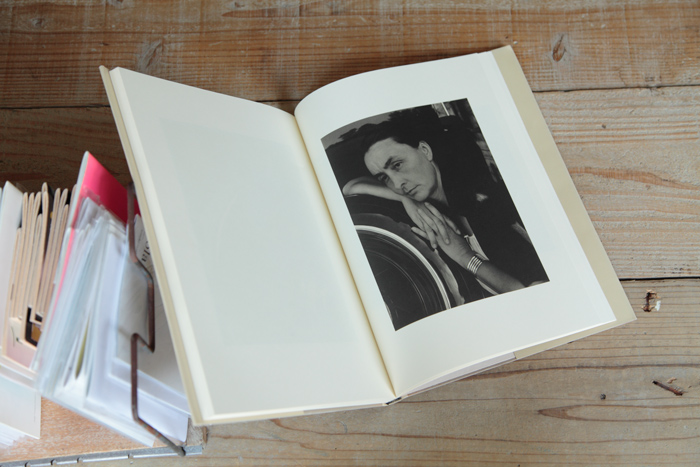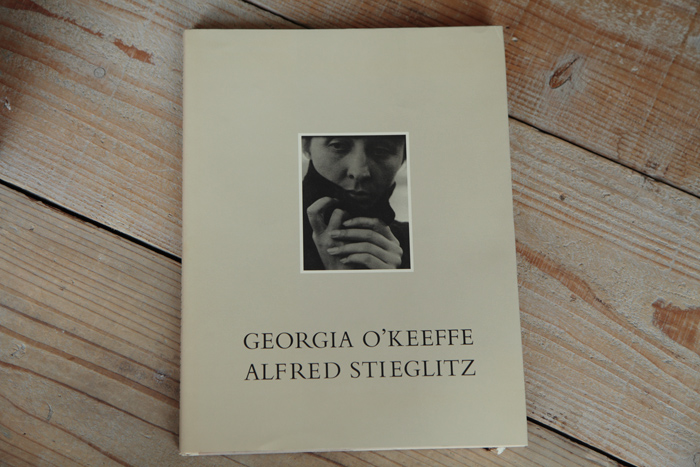前回紹介した『オキーフの家』が、オキーフ最晩年の美しさを伝えていたならば、本書はオキーフ30代40代(1917年-30年)の美しさを伝える写真集です。撮影したのは、オキーフの夫であり、近代写真の父と称されるアルフレッド・スティーグリッツです。
スティーグリッツにはギャラリストとしての側面もあり、ニューヨーク5番街291番地にギャラリー「291」を構え、まだ日の目を見ない、セザンヌやピカソ、マチス、ブランクーシらの作品を紹介していました。1916年、スティーグリッツは初めてオキーフの木炭画に出会います。その時、「ついに女性の画家があらわれた!」と叫んだと言われています。そして、早々に「291」でのオキーフ展が実現しました。(この展覧会はオキーフの承諾がないまま行われたので、当初オキーフは憤慨したそうです。)二人は恋愛関係に発展し、紆余曲折を経て、ギャラリストと作家は結婚に至りました。このときスティーグリッツ60歳、オキーフ37歳。
ギャラリストの仕事が、作家の1の魅力を10に引き出すプロデュースにあるなら、スティーグリッツのオキーフに対するそれは、この写真集を見る限り、いまでも確実に成功しています。
本書に写されたオキーフは、艶やかで、鋭く、ときとして険しい表情を浮かべています。艶やかさは、スティーグリッツへの思慕の念。鋭さは、表現者としての自信。険しさは、恋愛の揺らぎと見てとれるかもしれません。また、画角に取り込まれた「手」が、静止しているはずの写真に、動きを与えています。
これらの要素が相まって、オキーフが放つすさまじいエネルギーが写真の皮膜に封じ込められ、項(ページ)をめくるごとに、その波動をリズミカルに感じることができます。 神秘的且つ官能的と形容できるようなイメージ。そして何よりすごいのは、このイメージを、記録ではなく、芸術の分野に落とし込んで、時を越えた私たちの前に可視化していることです。或いは、記録と芸術が同化したとも言い換えられます。芸術は人間の存在の根源を問うからです。
いずれにしても、写真の持てる力を最大限に引き出そうとするスティーグリッツの意欲、写真の描写力を信頼し、それに自身の精神を託そうとするオキーフの思い。これが本書の美しさを支える基調低音になっているのだと思います。
 PHOTOGRAPHY BY KAZUO MINATO
PHOTOGRAPHY BY KAZUO MINATO
If“Georgia O’Keeffe and Her Houses: Ghost Ranch and Abiquiu”that I introduced last time shows her beauty in her later years, this book is a collection of photographs that shows O'Keeffe's beauty in her 30's and 40's (1917-1930). O'Keeffe's husband, called the father of modern photography, Alfred Stieglitz is photographed.
It is said that Stieglitz had another side as a gallery owner. He established 291 at 291 Fifth Avenue in New York, where he showed works by Cézanne, Picasso, Matisse, and Brancusi that had not yet seen the day of light. In 1916, Stieglitz first came across O'Keeffe's charcoal drawings for the first time and exclaimed, “At last, a woman on paper.”Then, he quickly held an O'Keeffe exhibition at 291. (The exhibition was held without O'Keeffe's consent, so she was furious at first.)
The two developed a love relationship and, with a few bumps and detours, the gallery owner and artist eventually married. Stieglitz was 60 and O'Keeffe was 37 at the time.
If a gallery owner's job is in productions where he draws a 10 out of the artist's charm of 1, Stieglitz work with regard to O'Keeffe is even now undoubtedly successful from looking at this photograph collection.
The O'Keeffe pictured in this book is elegant and sharp, and occasionally wears a grim look on her face. Her elegance is her attachment to Stieglitz. Her sharpness is her confidence as an expressionist. Her grimness might be a sign of their fluctuating love. Her hand trapped in an angle adds movement to a still photograph.
These elements combine, the tremendous energy O'Keeffe gives off is contained in the film of photographs, and at every turn of the page you can feel her surge rhythmically. Images that you can describe as mysterious and sensual at the same time. Most amazing of all, we transcendents of time can see the image before ourselves because it is reflected not in recordings but in fine art. Alternatively, you could say that recordings and fine art have merged, because fine art questions the root of human existence.
At any rate, I think that Stieglitz's drive to attempt to draw out the power of photographs to their maximum and his belief in photographs's power of depiction, and the desires of O'Keeffe attempting to entrust her own spirit to him is the basic undertone that supports the beauty of this book.
 PHOTOGRAPHY BY KAZUO MINATO
PHOTOGRAPHY BY KAZUO MINATO

 PHOTOGRAPHY BY KAZUO MINATO
PHOTOGRAPHY BY KAZUO MINATO